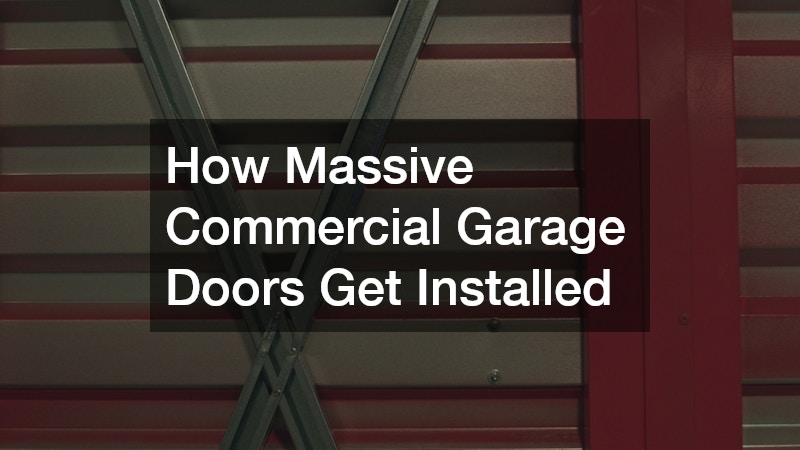Massive commercial garage doors are vital components for warehouses, industrial facilities, and large-scale commercial operations. They provide secure access for vehicles, equipment, and personnel while contributing to energy efficiency and workplace safety. Unlike residential doors, commercial doors are larger, heavier, and more complex, requiring specialized materials, tools, and expertise for proper garage door installation in Virginia. The process involves careful planning, precise assembly, and thorough safety measures to ensure that the doors function reliably for years.
In this article, we’ll explore the types of commercial garage doors, the materials and tools required, and the step-by-step installation process, offering insight into how these essential structures are brought to life.
What Are the Types of Massive Commercial Garage Doors Available?
Roll-Up Doors
Roll-up doors are among the most common choices for commercial applications due to their space-saving design. These doors consist of interlocking metal slats that roll into a compact coil above the opening. Roll-up doors are ideal for loading docks, garages, and storage facilities where ceiling clearance is limited. Their durable construction provides excellent security and can withstand heavy usage, making them a practical solution for high-traffic areas.
Sectional Steel Doors
Sectional steel doors are composed of individual panels connected by hinges that move along vertical and horizontal tracks. These doors are highly versatile and offer strong insulation and durability. They are commonly used in warehouses, manufacturing plants, and commercial garages that require wide openings and frequent use. Sectional doors can also be customized with windows or reinforced panels to suit specific operational needs.
High-Speed Fabric Doors
High-speed fabric doors are designed for rapid opening and closing, which is essential in environments requiring efficient workflow and temperature control. Made of reinforced fabric with flexible edges, these doors are lightweight and can operate several times faster than traditional steel doors. They are particularly useful in food processing plants, logistics centers, and cleanroom environments where maintaining a stable interior climate is critical.
Aluminum Glass Doors
Aluminum glass doors combine durability with modern aesthetics. They provide excellent visibility while allowing natural light into commercial spaces, making them suitable for showrooms, automotive dealerships, and corporate garages. Aluminum frames offer strength without excessive weight, and tempered glass ensures safety while maintaining transparency and appeal.
Insulated Garage Doors
Insulated commercial garage doors are designed to enhance energy efficiency and maintain internal temperatures. They feature cores of polyurethane or polystyrene sandwiched between steel panels. These doors are ideal for facilities where temperature control is crucial, such as refrigerated storage units, manufacturing plants, and climate-sensitive warehouses. By reducing heat loss or gain, insulated doors also help lower energy costs while improving workplace comfort.
What Materials and Tools Are Required?
Door Panel Materials
Commercial garage doors are built from materials designed for durability and longevity. Steel is the most common choice due to its strength, impact resistance, and low maintenance. Aluminum is favored for lightweight applications, while reinforced fabric is used in high-speed doors. Panels are often insulated to improve energy efficiency and reduce noise. Choosing the right material depends on the specific requirements of the commercial facility, including security, frequency of use, and environmental conditions.
Hinges and Tracks
Hinges and tracks are critical for smooth and reliable door operation. Heavy-duty hinges connect panels in sectional doors, while tracks guide the door’s vertical and horizontal movement. Commercial tracks are reinforced to handle the weight of large doors, and they must be installed with precise alignment to prevent malfunction or excessive wear.
Spring Mechanisms
Springs play a central role in counterbalancing the weight of commercial garage doors, making them easier to open manually or via an automatic system. Torsion springs are mounted above the opening and provide consistent tension, while extension springs are positioned on the sides. Proper installation and adjustment are essential for safety and efficient operation, as incorrectly set springs can cause accidents or door damage.
Safety Equipment
Installing massive garage doors involves working with heavy components and high-tension systems, so safety is paramount. Installers typically use hard hats, steel-toed boots, gloves, eye protection, and fall protection gear. Proper safety measures prevent injuries and ensure the installation process proceeds smoothly.
Installation Tools
Specialized tools are required to handle large doors, including drills, socket wrenches, levels, clamps, spring adjustment tools, and lifting equipment. For particularly large or heavy doors, forklifts or hoists may be used to position panels safely. High-quality tools and equipment are essential to maintain precision and reduce the risk of accidents during installation.
What Is the Step-by-Step Installation Process?
Assembling Door Panels
The first step involves assembling the door panels on-site or preparing pre-assembled panels for installation. Panels are aligned and connected using heavy-duty hinges and fasteners. Installers check for smooth articulation between panels and confirm that the dimensions match the garage opening to ensure a seamless fit.
Installing Tracks and Brackets
Next, vertical and horizontal tracks are mounted and secured with brackets. Proper alignment is crucial, as even slight deviations can affect the door’s operation. Installers use levels and measuring tools to ensure tracks are perfectly aligned and anchored to the building structure. This step sets the foundation for smooth and reliable movement of the entire door system.
Attaching the Spring System
Once the panels and tracks are in place, the spring system is installed. Torsion or extension springs are carefully mounted and adjusted to balance the door’s weight. This process requires precision and expertise, as improperly set springs can create dangerous tension or cause the door to operate inefficiently. Professionals use specialized tools to measure tension accurately and secure springs safely.
Installing the Garage Door Opener
For automated operation, the garage door opener is installed after the door is assembled. Openers are mounted to the ceiling or wall and connected to the door using a trolley or arm mechanism. Electrical connections are made in compliance with safety codes, and the system is calibrated to ensure smooth opening and closing. Modern openers may include safety features such as motion sensors, auto-reverse, and remote monitoring capabilities.
Safety Checks and Adjustments
The final stage involves comprehensive safety checks and operational testing. Installers verify that the door opens and closes evenly, springs maintain proper tension, tracks are aligned, and the opener functions reliably. Sensors, emergency releases, and locking mechanisms are tested to confirm compliance with safety standards. Adjustments are made as needed to ensure long-term performance and reduce the risk of malfunctions.
Conclusion
Installing massive commercial garage doors is a complex, multi-step process that requires precision, specialized tools, and expert knowledge. From selecting the right type of door—whether it’s a roll-up, sectional steel, high-speed fabric, aluminum glass, or insulated model—to assembling panels, installing tracks, attaching spring systems, and performing thorough safety checks, each stage is critical to ensure reliable and safe operation. Proper installation not only extends the longevity of the door but also enhances security, energy efficiency, and workplace functionality. Understanding the materials, tools, and techniques involved in commercial garage door installation allows businesses to make informed decisions and maintain smooth, efficient operations for years to come.


